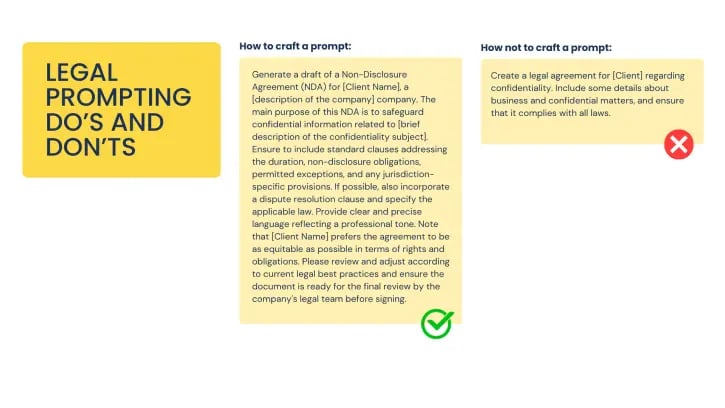Guide to optimise your legal prompts for generative AI
No good prompts, no reward. Generative Artificial Intelligence (AI) tools surround legal departments, promising great efficiency and productivity, but they won't find the treasure if they don't have the map to find it. That's why in this blog post we're providing the map you need, a guide to how you can make the most of AI to help you with many of your more manual tasks.
In the fast-paced world of generative artificial intelligence (AI) applied to the legal sector, the quality of your prompts is critical. Whether you're a lawyer or in the legal tech world, creating effective prompts to consult with generative AI is essential for accurate and relevant results. In this blog post, we'll explore a basic guide with five must-know tips, provide some practical examples of prompts for lawyers, and look at the importance of reviewing generated content. We'll also highlight why training in AI is essential and explore tools tailored to the legal sector. Are you ready? Let's get started!
The science of prompts: what is legal prompting?
Legal prompting is defined as the process by which a lawyer interacts with a generative artificial intelligence via chat, including instructions in natural language (input), from which the AI is expected to provide a response also in natural language (output). We will measure the quality of the prompting based on whether the output is useful and tailored to the lawyer's needs. This method involves the creation of precise and coherent questions and requests, with the necessary data to generate the desired response from the generative AI. It is a fundamental technique to take advantage of this.
A basic guide to drafting prompts
OK, you know what legal prompts are, but how do I create my first prompts? The truth is that there are a number of variables you need to consider when talking to the AI. You will find that it will be able to keep up with you if your questions are well thought out and take into account the following parameters:
Explain yourself: provide context and tone cues:
- Provide relevant contextual details in the prompt to help the model better understand the scenario.
- Provide tone cues, specify the role you want the AI to take in formulating the response.
Clarity and specificity:
- Clearly define what you want to achieve with your prompt. Ask direct questions to get concrete answers.
- Be specific in terms and conditions to get more precise answers.
- Avoid ambiguities that may lead to incorrect interpretations.
Consider synonyms and variants:
- Anticipate different ways of expressing an idea. Identify and use keywords relevant to your legal area.
- Include synonyms and variations to cover a broader spectrum.
Test, adjust, optimise:
- Perform iterative training to improve model accuracy. Adjust prompts according to the results obtained and feedback on the model to improve its performance.
- Regularly tests prompts in practical situations. Evaluate the quality of responses and adjust prompts as necessary. This helps to improve the effectiveness of the model over time.
How to make a prompt vs. how not to make a prompt
If you apply the basic ideas above to your prompt generation, you will see that the results provided by AI are of higher quality. This technology is designed to give you results that are proportional to the quality of your prompt. This means that the more detailed and specific your prompt is, the better the result will be. On the other hand, if your prompt is poor in content, the result will also be poor. Consider the following example:
Another very effective trick to get your prompts is to follow the "role - task - format" concept. This is a very practical approach to how you want to receive the AI output:
Lawyers must be at the centre of technology
Reviewing AI-generated content is essential. Generative AI is capable of producing impressive results, and very rich content that can help lawyers in their day-to-day work. But it can also sound very convincing if it doesn't really know what it's talking about. An AI model, no matter how well trained, can suffer from hallucinations because it is not a rational entity, although many say it is something like the Terminator.
Lawyers need to monitor the generated content to ensure that it is error-free and that it is what the lawyer wants. In addition to ensuring that the result has the desired tone, adjustments should be made for certain technicalities and nuances that the generative AI does not cover:
- Accuracy: Revision ensures that the information is accurate and up to date.
- Contextual adaptation: Adapts responses to specific and changing contexts.
- Bias avoidance: Identifies and corrects potential biases in content.
You may be interested in: How to apply AI in legal tech: what can it do for lawyers?
Keep up to date, learn more about prompts
Since its emergence at the end of 2022, revolutionising everything from everyday aspects to the very foundations of craft design, AI has continued to evolve and change. As a result, it's important to keep up with the latest trends and educate yourself in the field. There are many sources of information, as well as legal prompting courses, which already cover the latest in this technology in depth. Explore, research and keep up to date with this technology that is sure to be the talk of the town.
And that's it for today's article on prompts for your legal department! You have read this far, so we can see that you are interested in artificial intelligence and what it can do for you. So let us recommend you the next read, our ebook "Generative AI: The revolution of the legal function". Discover a complete guide to how this technology can help you in your legal department.
See you in the next article!
 By
By





